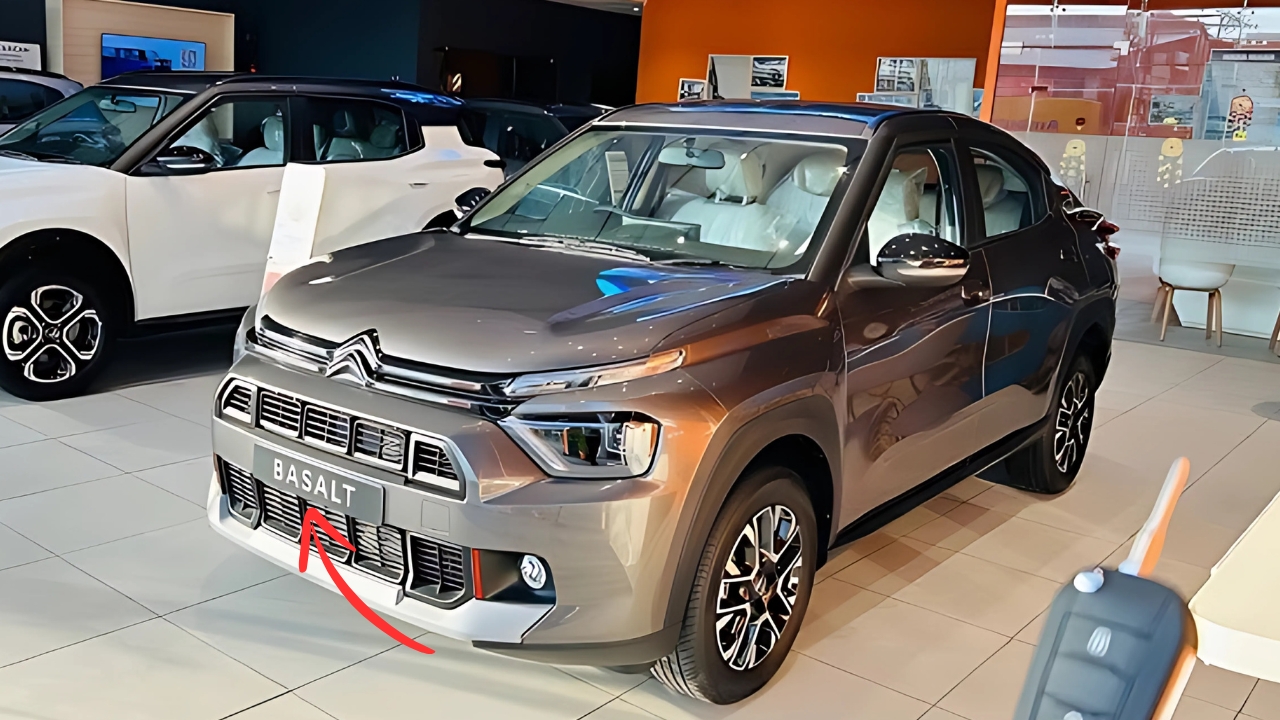Citroen Basalt : When Citroen launched the Basalt in August 2024, they weren’t just introducing another SUV – they were attempting to create an entirely new category in India’s conservative automotive market. Priced from ₹8.32 lakh, this “SUV-Coupe” promises to combine rugged SUV capability with sleek coupe elegance. But in a market where buyers prioritize practicality over style statements, can Citroen’s design-first approach actually succeed?
Design Philosophy That Divides Opinion
The Basalt immediately stands out with its sloping roofline that gives it genuine coupe proportions rather than just SUV bulk. At 4,352mm long and 1,593mm tall, it maintains SUV practicality while creating a silhouette that’s genuinely different from anything else in its price bracket.
The front fascia borrows heavily from the C3 Aircross with LED lighting and Citroen’s characteristic split grille design. Dual-tone alloy wheels and available two-tone roof options add visual interest, while the overall stance suggests movement even when stationary.
However, the coupe roofline creates compromises that practical-minded Indian buyers might not appreciate. Rear headroom suffers compared to traditional SUVs, and the sloping rear window reduces cargo accessibility despite the claimed 470-liter boot space.
Still, there’s no denying the Basalt looks distinctive in a segment filled with increasingly similar designs. Whether buyers value this uniqueness over maximum practicality remains the crucial question.

Interior Space That Actually Surprises
Despite the coupe styling, Citroen managed to create surprisingly spacious interiors. The 2,651mm wheelbase provides generous rear legroom, while clever packaging ensures the cabin doesn’t feel cramped despite the sloping roofline.
The dual-tone black and grey dashboard creates a premium ambiance that belies the affordable pricing. Build quality feels solid for the segment, with soft-touch materials in key areas and thoughtful storage solutions throughout.
The 10.23-inch touchscreen infotainment system with wireless Android Auto and Apple CarPlay keeps technology current, while the 7-inch TFT instrument cluster offers three customizable display modes. Features like automatic climate control, wireless charging, and multiple USB ports show Citroen thinking about modern connectivity needs.
Rear passengers benefit from 3-step under-thigh adjustment – a thoughtful touch rarely seen in budget SUVs that shows genuine attention to passenger comfort.
Performance Options That Cover the Bases
The Basalt offers two engine choices that cater to different priorities. The base 1.2-liter naturally aspirated engine produces 82 horsepower – adequate for city driving but struggles with highway overtaking. Fuel efficiency reaches 18 kmpl, making it suitable for budget-conscious buyers.
The more compelling option is the 1.2-liter turbocharged engine delivering 110 horsepower and 205 Nm of torque. This unit provides genuine performance with strong mid-range pull that makes highway driving enjoyable. Fuel efficiency drops slightly to 18.7-19.5 kmpl depending on transmission choice.
Transmission options include 5-speed and 6-speed manuals plus a 6-speed torque converter automatic. The automatic works smoothly enough for city driving, though it lacks the responsiveness that enthusiast drivers might prefer.
The 180mm ground clearance handles Indian road conditions adequately, while the suspension setup prioritizes comfort over sporty handling – exactly what most buyers in this segment actually want.
Safety and Features That Matter
Citroen equipped the Basalt with over 40 active and passive safety features as standard, including six airbags, Electronic Stability Program, and Hill Hold Control. ISOFIX child seat anchors come standard across all variants, showing attention to family safety needs.
The comprehensive safety package helps justify the pricing while addressing concerns about European brands skimping on features for Indian markets.
Market Reality Check
Sales figures tell the story – just 95 units sold in May 2025 compared to thousands for conventional SUVs in this segment. The Basalt competes against established players like the Hyundai Creta, Kia Seltos, and newer entries like the Tata Curvv.
While the Basalt offers distinctive styling and solid engineering, Indian buyers have consistently chosen proven practicality over design innovation. The limited dealer network and uncertain resale values add additional hurdles for potential buyers.
Realme Note 60 – 256GB internal storage launch with shandar design
Value Proposition Assessment
At current pricing, the Basalt offers decent value for buyers specifically wanting SUV-coupe styling. The build quality, features, and engineering feel solid, while the distinctive design ensures it won’t blend into traffic.
However, the same money buys more established alternatives with better dealer networks, proven reliability records, and stronger resale values.
Citroen Basalt Final Verdict on Citroen’s Gamble
The Basalt represents everything right and wrong with Citroen’s Indian strategy. The engineering is solid, design is distinctive, and features are competitive. But success requires more than good products – it needs buyer acceptance of the brand’s philosophy.
For buyers specifically wanting something different and willing to accept the compromises that come with unique design, the Basalt delivers genuine appeal. Whether enough Indian buyers share this priority to make the model commercially viable remains Citroen’s biggest challenge.
The Basalt proves that different doesn’t always mean better in practical terms, but sometimes being memorable matters more than being measurably superior.
